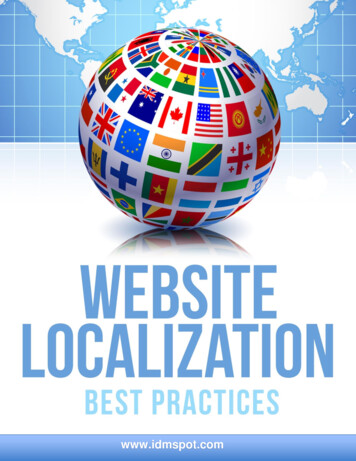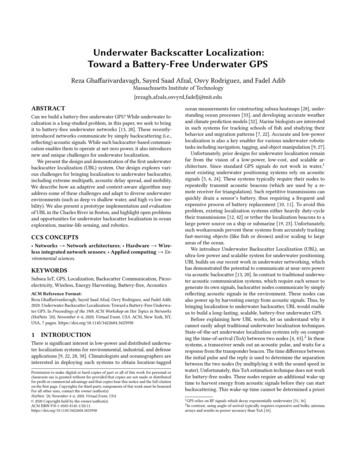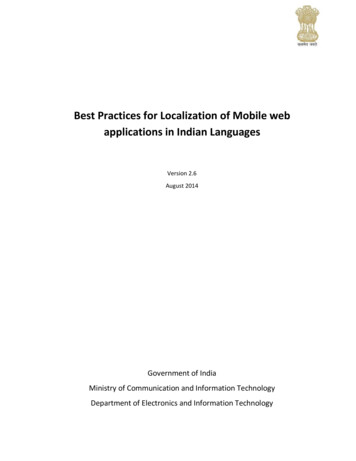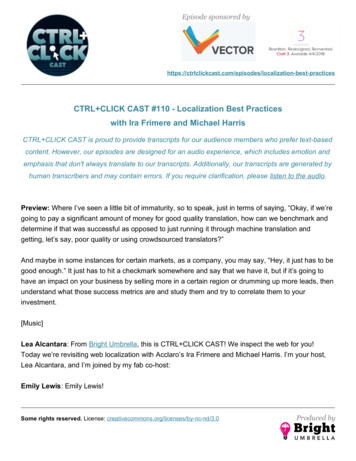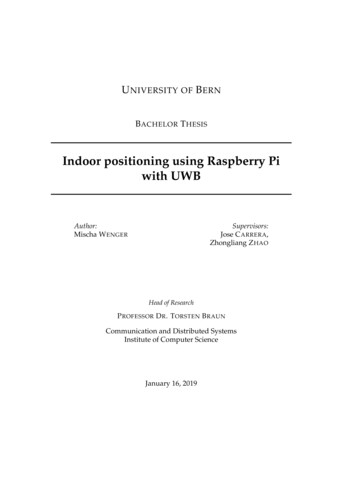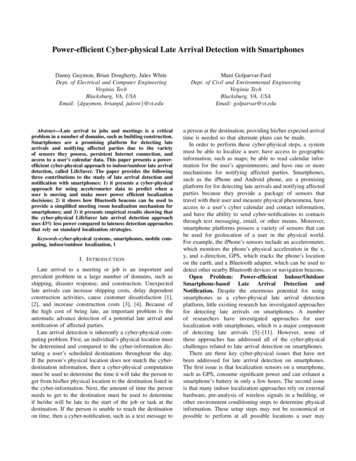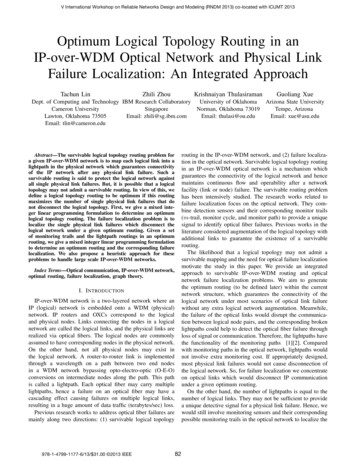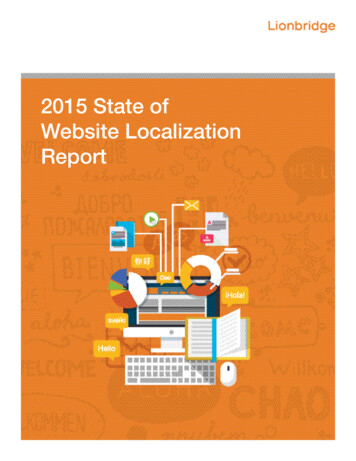
Transcription
2015 State ofWebsite LocalizationReport
IntroductionGlobal brands have embraced a multichannel approach toattracting, engaging, and growing customers. Many have alsoadopted a global-local philosophy, imbuing brand messaging withlocal nuance to deliver personalized experiences.Their digital properties—especially their websites— are pivotal to thiseffort. However, offering a native language web experience to globalvisitors has been a challenge for many brands.Today there are multiple options for website localization.Cloud-based technologies, sophisticated translation engines, andindustry consolidation have resulted in a robust localization market.Crafting a multilingual website is now within reach of many brands.So to what extent are brands transformingtheir websites to connect with globalcustomers?We asked global business professionals to tell us what they’re doingto speak the language of their worldwide customers. Over a fourweek long period, more than 200 participants from 31 countriescompleted Lionbridge’s 2015 State of Web Localization Survey. Weinvite you to share in their insights. 2015 Lionbridge www.lionbridge.comPAGE 2
Summary of FindingsThe Lionbridge 2015 State of the Web Localization Survey,asked respondents to describe their web localizationefforts, including: localization strategy, quantity of languagespublished, what content they choose to localize and howfrequently they do so, and preferred CMS platforms.Additionally, we wanted to know who has primary responsibilityfor publishing localized content, their biggest challenges, andnear-term expansion plans.For our respondents, customer engagement is drivinglocalization. The majority of participants are localizing theirwebsites, and they’re doing so in the name of customerservice and brand consistency: More than half (62.3%) of organizations take a strategic approach to website localization Their strategic drivers were overwhelmingly customerexperience (82.6%) and brand consistency (67.4%),broadly outpacing content reuse (43%) and cost (37.2%)More than 60% of respondents take a centralized approachto localization, and responsibility for localization falls toMarketing in over half (53.5%) of the firms surveyed. Additional findingsof note: 5 or fewer languages: 44% oforganizations who localize targetfive or fewer languages Customer content is key: Over90% of respondents localizecustomer-focused content suchas solution/product informationweb pages Ongoing need for content: 39.5%need content localized weekly Broad range of CMS platforms inuse: there was no stand-out webpublishing platform named Mixed expansion plans: Lessthan half (44.2%) are planning onexpanding into new markets inthe next three yearsTranslation quality (55.8%) was the top websitelocalization challenge, followed by cost (41.9%), materialsprep (32.6%), and cultural considerations (27.9%).The majority of this year’s survey respondents are pursuing awebsite localization strategy; however, nearly 40% are stillwithout strategic approach, representing a substantialarea for growth. For those who localize, there is no typicalwebsite localization experience—companies vary widely inhow, what, and who localizes content. What they do have incommon is the need to develop and deliver fresh, high-quality,relevant web content that supports their brand and enhancescustomer experiences. 2015 Lionbridge www.lionbridge.comPAGE 3
“A localized website, withgood content in the customer’slanguage, is key to ensure thecustomer is continually engagedwith your brand and yourproducts and services.”— Connor RobinsonSolution Architect for LionbridgeSurvey Questions & Responses
Question 1: Does your company have awebsite localization strategy?Takeaway: Survey respondents indicated that themajority have a localization strategy. However, withalmost 40% of companies still without a websitelocalization strategy, there is room for improvement.It is difficult to find the balance between global and localmessaging. Determining where localization efforts shouldbe placed adds another layer of complexity to websitedevelopment and management. But the 40% without astrategy risk getting left behind by their peers who are treatinglocalization as a business imperative, elevating localization’sprofile and increasing the level of formalization required.Companies may choose to pursue localization without aformal strategy but, in order to meet specific goals andchallenges, a strategic approach is necessary to direct,measure, and adjust localization efforts.“This data shows that most companies continue tobe focused on the benefits that a truly global webpresence can bring to organizations. Buyers arenow researching and educating themselves on yourproducts and services through engaging contentthat is in their own language. A localized website,with good content in the customer’s language, is keyto ensure the customer is continually engaged withyour brand and your products and services.” 2015 Lionbridge www.lionbridge.comConnor Robinson Solution Architectfor LionbridgePAGE 5
The following questions (2-11) are responses fromthe 62.3% who indicated they have a strategyin place—from target markets to the companylocalization process.Question 2: What are the drivers for yourlocalization strategy? (check all that apply)Takeaway: Survey respondents overwhelminglyselected Customer Experience as a key driver fortheir localization strategy, followed by BrandConsistency, Content Reuse, and Cost.For the past decade, marketers have been focused onshaping and enriching customer journeys and making brandspersonal. Communicating with someone in their nativelanguage is paramount for personalization. Users developa higher level of comfort and trust when presented withcontent they fully understand, and companies can use theanalytics from visits, purchases, and social shares to furtherpersonalize the brand experience.Brand consistency can be a victim of ad hoc or locallymanaged localization, as content managers may underminebrand guidelines in an effort to reach local audiences.Centralized localization efforts (as explored in the followingquestion) go a long way in preserving brand look and feelwhile allowing for regional preferences.Content reuse is a hot button for all marketers, not justthose who localize. Redeploying content across channels andlanguages saves time, money, and resources. Localizing the“best of” content across markets is a clear best practice formany.Cost is a driver for over one-third of localizers. However, themultitude of translation options available, from automatedmachine translation (MT) to high-quality human translation,allow companies to decide on their translation method tomeet cost constraints. Question 11 examines attitudestoward translation quality and localization. 2015 Lionbridge www.lionbridge.comPAGE 6
Question 3: How are localization requestshandled today? (Select all that apply)Takeaway: 61.6% of respondents have centralizedtheir localization efforts. For the balance ofrespondents, almost 40% identified theirorganizations as having a decentralized approachto managing localization, including ad hoc efforts(12.8%) and/or agency-managed (7%).The previous question identified customer experience, brandconsistency, and cost as key localization strategy drivers.Centralization greatly contributes to consistency in userexperiences, brand representation, and minimizes costsand duplication of effort. It also supports content reuse,identified as another localization driver. Given the right suiteof marketing tools and language partner, a small centralizedteam can have a global impact. Adoption of cloud-basedCMS tools (see Question 6) also tends to support the brand,user experience, and cost savings elements of centralizedlocalization management.Question 4: How many languages do youtranslate your website into?Takeaway: More than half (55%) are translating tenor fewer languages, with two as the most prevalentnumber translated, followed by one, three, and fourlanguages respectively.When asked how many languages they are translatingtheir website into, respondents returned a broad range ofresponses, from one to 144.For the 44% translating 11 or more languages, 15 and 20languages were the most frequently cited by survey takers.Based on current Internet user statistics, right now it takesten languages to reach 84% of internet users. According toInternet World Stats, as of 2013, the top online languagesare: English; Chinese; Spanish; Arabic; Portuguese;Japanese; Russian; German; French; Malay. 2015 Lionbridge www.lionbridge.comPAGE 7
Question 5: What team or department isresponsible for localizing websites?Takeaway: By a large margin (53.5%), Marketinghas responsibility for website localization among ourrespondents.Following Marketing, 14% of respondents selected All ofthe Above—Marketing, IT, Localization, and others—a crossfunctional group of stakeholders and contributors.Localization (11.6%) and IT (10.5%) and Other (10.5%)follow. The Other (10.5%) response group included corporatecommunication, digital groups, and outsourced management.“Marketing departments still hold the lion’s share ofthe responsibility when it comes to web localization,but the landscape has become much moretechnical than before.Today, client teams need to sort through the clutterof digital marketing and the ever-growing list ofplatforms and tools that are added to the mix, allwhile trying to elevate their customer experience andbrand awareness via their global websites.” 2015 Lionbridge www.lionbridge.comGabe Rodino LionbridgeSolution ArchitectPAGE 8
Question 6: What CMS platform do youuse? (Select all that apply)Takeaway: The most-used systems are Wordpress(22.1%), Microsoft Sharepoint (17.4%), and AdobeExperience Manager (CQ5) and Sitecore at 15.1%each.In this question, respondents were able to select multipleresponses, but did not clarify CMS use per market or users.Companies may be using multiple systems for marketsor audiences, such as Adobe for external content andSharePoint for internal users.There are many content management systems to choosefrom and respondents have made use of their options,indicating their preferences from 12 named systems and asmany write-ins. The biggest names in multilingual-friendlysystems came in toward the middle of the pack.The most-used systems are Wordpress (22.1%), MicrosoftSharepoint (17.4%), and Adobe Experience Manager(CQ5) and Sitecore at 15.1% each.The top group was followed by Oracle WebCenter andDrupal at 8.1% each, SDL Tridion (5.8%), HP Teamsite (4.7%)named by multiple respondents.Custom platforms accounted for 7.3% of systems used. 2015 Lionbridge www.lionbridge.comPAGE 9
Question 7: What is the most importantaspect of website localization for you?Takeaway: Survey Quality/Accuracy (39.5%) wasthe top response, far exceeding Price/Cost (8.1%)and Turnaround Time (2.3%).When asked to name their most important aspect of weblocalization, the leading answers—Quality/Accuracy andCustomer Experience—underscore the participants’ keylocalization drivers (Question 2) of customer experience andbrand consistency.Quality/Accuracy (39.5%) was the top response, farexceeding Price/Cost (8.1%) and Turnaround Time (2.3%),two frequent translation and localization metrics. FollowingQuality is Customer Experience (33.7%) and DrivingIncremental Revenue (11.6%).For respondents, it is not enough just to translate orlocalize, it must be done well, regardless of number oflanguages. With improved accuracy comes consistentcustomer experiences; increased customer engagement andincremental revenue are likely to follow.“Often, to contain costs,companies who are just goingglobal will let in-market partners/distributors handle localization (whichmay mean that someone in the officewill try to do it in their spare time).A full-service LSP understands thatclients need “different horses fordifferent courses” and will adapt theirapproach to achieve the appropriatequality in the translations.”—Walter Smith, Lionbridge Solution Architect
Question 8: What types of content do youlocalize? (Select all that apply)Takeaway: Respondents overwhelmingly cited theirProduct/Service/Solution pages (93%) as the topcontent for localization.In pursuit of optimizing the customer experience and drivingrevenue, respondents overwhelmingly cited their Product/Service/Solution pages (93%) as the top content forlocalization. Campaign/Landing Pages were named byover two-thirds (68.6%), and data-rich Marketing Assets(55.8%) including ebooks, solution briefs, and white papersrounded out the top three.SEO-friendly News and PR (52.3%) and social-friendlyVideo and Multimedia (43%), Events (39.5%), and Blogs(36.1%) rounded out the types of content participantschoose to localize.Ten percent of respondents also localize User-driven Content,including support and wiki pages. Content in the Othercategory includes legislation, learning content, apps, and usermanuals.“Earlier in the survey respondents indicated that customer experience was a top driverfor localization (82.6%). Most global companies consider the full lifecycle of thecustomer – pre-sales, buying, and post-sales. It’s important to remember the postsales customer support content that makes a concrete difference in customersatisfaction scores. Benefits aren’t just limited to an increase in the CSA scores;localized content can serve to divert calls from CSRs to the website, for significantpotential cost savings.”—Walter Smith, Lionbridge Solution Architect 2015 Lionbridge www.lionbridge.comPAGE 11
Question 9: How often do you needcontent localized?Takeaway: Nearly forty percent of respondentsneed content localized weekly (39.5%), andanother 26% need it monthly.Nearly forty percent of respondents need content localizedweekly (39.5%), and another 26% need it monthly.Just over 12% of respondents need biweekly localizedcontent, and five percent need it bimonthly. Ten percenthave a quarterly need, but 3.4% need fresh localizedcontent daily or several times a week.Organizations who are able to master content reuse acrosslanguages will have a much easier time keeping up withdemands for new and relevant content. Cloud-basedcontent management systems, integration technologies, andtranslation tools make frequent content localization easier andfaster.Question 10: Are you looking to expandinto new markets in the next 1-3 years?Takeaway: Organizations who are holding their expansion plans for the next few years (55.8%) edgeout those who do plan to expand (44.2%).Organizations who are holding their expansion plansfor the next few years (55.8%) edge out those who doplan to expand (44.2%). For those planning to expand,there was no market leader identified in the comments,with participants citing Asia/APAC, Europe, North America,“emerging markets” and the classic “world domination” astheir expansion targets.For these participants, as well as those from the nonexpansion minded organizations who are already taking partin cross-border trade, a multilingual website will be a musthave. 2015 Lionbridge www.lionbridge.comPAGE 12
“Digital marketing isglobal by nature, and withchallenging economic conditionsin the more traditional marketscompanies are increasinglysearching for growth opportunitiesin new regions or markets. Over theyears, web content has becomemore dynamic, more diverse,and increasingly targeted to localmarkets. As a result, up-to-date, locallanguage content has become criticalfor commercial success in any newmarket.”—Bert EsselinkLionbridge Business Development Director
Question 11: Select up to threechallenges you currently face localizingyour website.Takeaway: Translation Quality is not only the mostimportant aspect of website localization, but it’s thebiggest headache for our respondents.As previously indicated in Question 7,Translation Quality is not only the mostimportant aspect of website localization,but it’s the biggest headache for ourrespondents. Translation Quality (55.8%)surpassed Cost (41.9%) and MaterialsPreparation (32.6%) as the top challenge theyface in website localization.Cultural Considerations were a challenge for27.9% of participants, far outpacing Breadthof Languages at 15.1%.Beyond quality, cost, and culture, jugglingcontent and technology were cited asadditional challenges. Exporting and Reimporting Content (19.8%) was identifiedby almost one-fifth, as were managing thePace of Technology Change and WebsiteDesign Issues at 18.6% each. Additionally,17.4% identified Learning Curve/New toLocalization Management as a challenge fortheir organization.“Quality” is an oft-cited issue/challenge with the output of content translationefforts. More often than not, if content owners are using professional translationresources, these quality issues aren’t actual errors, such as typos, misspelledwords, or wrongly used terminology.Sometimes, inconsistencies, ambiguities, and errors in the source text can yield unexpected issues withtranslations, especially if no up-front collaboration between client, in-country stakeholder, and LSP takesplace.This can be mitigated with a simple kick-off call to review intended style and preferred terminology. Theresults are translation style guides and glossaries that provide consistency and quality across projects.For more emotive advertising and marketing content, creative briefs that helped inform the sourcelanguage content creation may need to be shared and adapted for translation.The key to reducing surprises in the tone and voice of the translation output (sometimes also castas “quality” issues) is to be “planful” initially, and as necessary, establish lines of communications toaddress questions that may arise during the translation process.”—Walter Smith, Lionbridge Solution Architect
The majority of this year’s surveyrespondents are pursuing a websitelocalization strategy; however, nearly40% are still without strategic approach,representing a substantial area forgrowth. For those who localize, thereis no typical website localizationexperience—companies vary widely inhow, what, and who localizes content.What they do have in common is theneed to develop and deliver fresh,high-quality, relevant web content thatsupports their brand and enhancescustomer experiences.Survey Participant Demographics
Question 12: What country/regiondo you reside in?Question 13: In what country is yourcompany headquartered?Demographic Data: Survey participantsrepresent 31 countries from North America,South America, Europe, Africa, and Asia.Demographic Data: Survey participantsrepresent companies from 29 countries around osta elgiumBulgariaCanadaChileCosta sHungaryIndiaIndonesiaIrelandItalyJordanMorocco 2015 Lionbridge enSwitzerlandTurkeyUnitedKingdomUnited yJapanNetherlandsPolandSerbiaSouth KoreaSpainSwedenSwitzerlandTurkeyUnited ArabEmiratesUnitedKingdomUnited StatesPAGE 16
Question 14: What is your primaryindustry?Demographic Data: Survey participantsrepresent a broad range of 29 industries, fromProfessional Services to Manufacturing toNon-Profit.Question 15: How many employeesare in your organization?Demographic Data: The majority (43.5%) ofrespondents work for companies with lessthan 1,000 employees, followed by thosewho work for large enterprises with more than10,001 employees (23.9%), 5000-1000employees (17.4%) and 1001-5000 employees (15.2%)respectively.Question 16: What best representsyour experience level?Demographic Data: Who are our surveyparticipants? Professionals (33.3%) andManagers (30.4%) make up more than half ofour respondents, with Directors (17.4%) andexecutives (11%) at the top stakeholder level.Administrative/Support personnel represent5.8% of participants. 2015 Lionbridge www.lionbridge.comPAGE 17
About LionbridgeContact UsLionbridge enables more than 800 world-leadingbrands to increase international market share, speedadoption of products and effectively engage theircustomers in local markets worldwide. Using ourinnovative cloud technology platforms and our globalcrowd of more than 100,000 professional cloudworkers, we provide translation, online marketing,global content management and application testingsolutions that ensure global brand consistency, localrelevancy and technical usability across all touchpoints of the customer lifecycle.To learn more about Lionbridge’sWebsite Localization ebsite-translation/ 2015 Lionbridge l www.lionbridge.comFor general information, visitwww.lionbridge.com
Drupal at 8.1% each, SDL Tridion (5.8%), HP Teamsite (4.7%) named by multiple respondents. Custom platforms accounted for 7.3% of systems used. Question 7: What is the most important aspect of website localization for you? Takeaway: Survey Quality/Accuracy (39.5%) was


